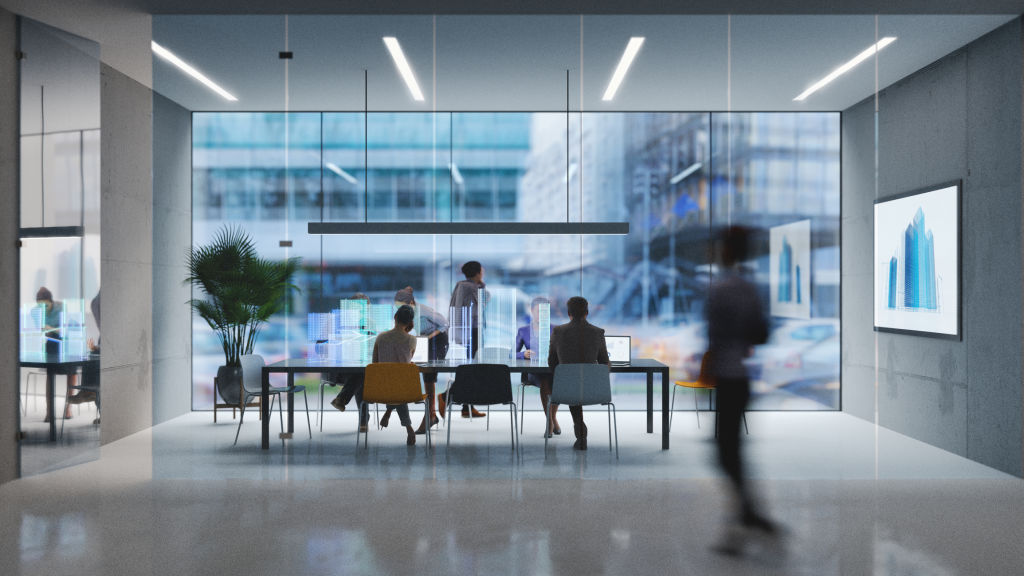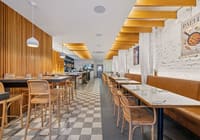
'Driven to new heights': The office of the future is already here
Famous science-fiction writer Arthur C. Clarke once asserted that “any sufficiently advanced technology is indistinguishable from magic”. The late futurist couldn’t have known how accurate his words would be in the aftermath of COVID-19.
Technologies are being driven to new heights in workplaces across Australia as businesses and workers alike demand safer and healthier environments.
The results are not magic, but when people walk through security entrances and order lifts without touching a single surface, it certainly comes close.
Pre-pandemic, touchless technology was a bonus for early adopters. But now it’s a must-have solution in common areas of all properties – apartment towers, shopping centres and most especially offices.
Powered by voice activation, smart devices, sensors or cloud-based access control systems, the common touch-points in the building such as door handles and lift buttons can be operated hands-free.
“If you look at technologies we’re seeing in real estate today, it comes down to the central theme of removing inconveniences and making better experiences,” explains Ben Christie, Colliers’ national director of office leasing.
He points to property fund manager ISPT’s 500 Bourke Street building in Melbourne where touchless access is among the initiatives being introduced as part of a redevelopment of the property by July 2023.
“It’s touchless entry into the building, so you’ll be able to use your phone to pretty much call a lift to access any of the common areas in the building whereas in the past you might have had to have touched the call button and used a swipe card,” Christie says.
With the knowledge COVID-19 was an airborne virus, a major hurdle in attracting workers back to the office was air quality.
A survey of 3000 worldwide workers by Honeywell found 60 per cent would leave their jobs if their employer didn’t take steps to create a healthier indoor environment. The survey results, released in February this year, also showed that nine out of 10 respondents wanted to be kept informed of their building’s air quality, yet only 15 per cent said they received regular updates.
Can landlords ensure bugs and other nasties wouldn’t be spread by air-conditioning units and heaters? Air purification upgrades are a matter of urgency – buildings without them are likely to lose out in the race to pull workers out of their home offices and back to the workplace.
The GPT Group has installed air purification systems that draw on UV technology to improve air quality across its office portfolio. It means air coming into a building is passed through an air handling unit that filters out bacteria, fungi and viruses.
Increased connectivity across collaboration spaces is yet another focus area. This means workers can find Wi-Fi wherever they are in a building, from the ground-floor cafe to the top-floor boardroom, says Louise Mason, Stockland’s chief executive commercial property.
“With the rise in hybrid working, there is also a realisation that collaboration and meetings will take place in many settings and technology needs to be able to democratise the work experience for participants,” she says.
“You should be able to have a great inclusive experience regardless of your work location.”
Other technologies workers can expect in the wake of the pandemic include innovations found in basement car parks such as electric car charging stations and number-plate recognition systems. But the most exciting technological advances are yet to come.
At 435 Bourke Street in Melbourne, CBUS is constructing a $1 billion, 48-level building with a ‘solar skin’ facade. Up to 20 per cent of the building’s electricity requirements will be generated on site by the solar exterior, while the balance of the building will be powered by off-site renewable electricity.
Meshing all types of technology across different areas such as sustainability and automation is key for landlords right now, says Peter Calwell, general manager at Melbourne building 101 Collins. “Advanced convergence of the building’s services offers cross-system optimisation, as well as AI [artificial intelligence] learning, to deliver deep data insights into how the building is being used in real time, supporting an ecosystem that allows our tenants to thrive,” he says.
“We have partnered with Cisco, one of our key tenants, to implement an enterprise-grade, converged network to support all of these underlying technologies, which allows these advanced smart-building features to improve our tenants’ day-to-day experience.”
Of course, none of this comes without a rise in lease costs. Tenants can expect to pay more, but to reap the rewards from the flow-on effects of a healthier, more productive workforce.
“I think the majority of building owners are looking at this and saying, ‘What’s the cost of not doing this?’” says Christie.
“If they don’t position themselves as providing a healthy and productive workspace, there’s every chance tenants are going to lease space down the road with another building owner who is adopting these initiatives.
“And if they relocate to one of these buildings and suddenly go ‘our absenteeism, our amount of sick leave is down’ and they can attribute that to coming to work each day in a healthier workspace, then that’s great in terms of the retention strategy for the building.”










